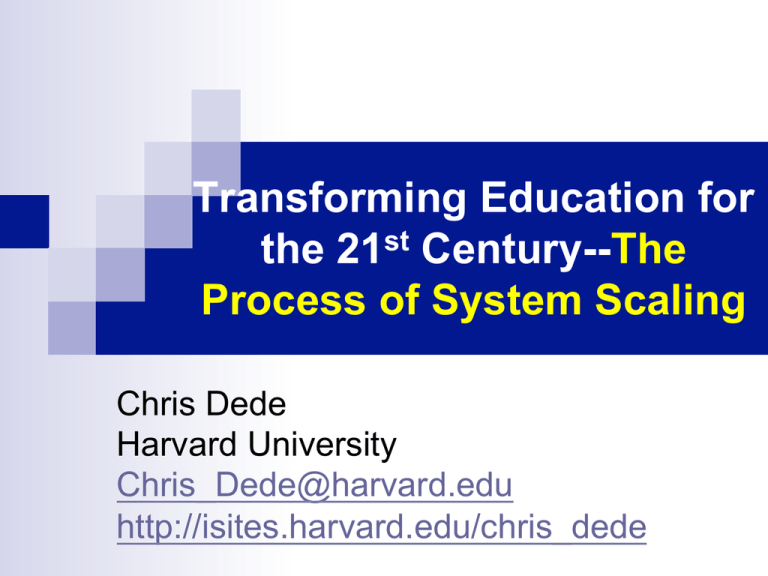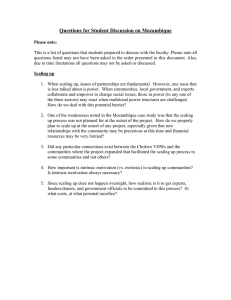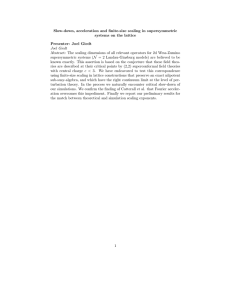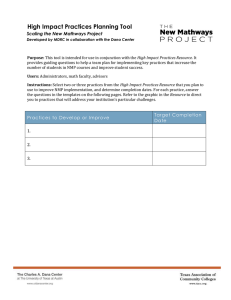Chris Dede Slides
advertisement

Transforming Education for the 21st Century--The Process of System Scaling Chris Dede Harvard University Chris_Dede@harvard.edu http://isites.harvard.edu/chris_dede Overview n A Grand Challenge in Education n Difficulties in Attaining Scale to Meet this Challenge n A Framework to Aid Designing for Scale n Implications for Ontario Initiatives US National Research Council (2012) Today's children can meet future challenges if their schooling and informal learning activities prepare them for adult roles as citizens, employees, managers, parents, volunteers, and entrepreneurs. Types of Knowledge/Skills Cogni&ve Outcomes Intrapersonal Outcomes Interpersonal Outcomes Cogni&ve processes and strategies Intellectual Openness Teamwork and Collabora&on Knowledge Work Ethic and Conscien&ousness Leadership Crea&vity Posi&ve Core Self-­‐Evalua&on Communica&on Cri&cal Thinking Informa&on Literacy Metacogni&on Responsibility Flexibility Conflict Resolu&on Reasoning Innova&on Ini&a&ve Apprecia&on of Diversity US National Research Council (2000) New evidence from many branches of science has significantly added to our understanding of what it means to know, from the neural processes that occur during learning to the influence of culture on what people see and absorb. 4 Dimensions of Design ¨ Learner-centered: preconceptions, needs, preferences, interests. ¨ Knowledge/skills-centered: what is to be taught, why it is taught, and what mastery looks like. ¨ Assessment-centered: diagnostic measures of learners’ thinking and doing that are formative for further instruction and learning ¨ Community-centered: encouraging a culture of collaborative questioning, respect, and risk taking [a context for the other three] 3 Contexts for Learning n Classrooms ¨ Presentation n Richly and discussion Contextualized Real World Learning ¨ Internships, n Learning apprenticeships Communities ¨ Interpretation and transfer face to face, virtual, blended A Grand Challenge 3 times 4 = 19 3 contexts 4 dimensions of learning 19 types of knowledge and skills cognitive, intrapersonal, interpersonal “Deeper Learning” n Case-based learning n Collaborative learning n Apprenticeships n Self-directed, n Learning life-wide learning for transfer n Interdisciplinary n Diagnostic studies assessments US National Science Foundation – Cyberlearning n An innovative type of learning A substantial technical advance necessary to support new learning approach n n A potentially transformational impact High Risk, High Gain European Learning Industry Group n we.learn.it – a network of European school children, teachers, and facilitators for exploratory and creative real life learning experiences n VISIR –collect, analyze and share micro innovation practices to propose a new vision for learning technologies in Europe Scaling Up Products n Adapting an innovation successful in some local setting to effective usage in a wide range of contexts ¨ Fast n food as example Need not be one-size-fits-all; can be personalized ¨ Apps n as illustration Technology as a lever for scale ¨ Can be used to automate or innovate, to make uniform or customized 1976 2014 The Spectrum of Social Media n Sharing ¨ ¨ ¨ ¨ n Thinking ¨ ¨ ¨ ¨ n Social bookmarking Photo–video-data sharing Social networking Writers’ workshops and fan fiction Blogs Podcasts Online discussion forums Twitter Co-Creating ¨ ¨ ¨ Wikis–collaborative file creation Mashups–collective media creation Collaborative social-change communities Overview n A Grand Challenge in Education n Difficulties in Attaining Scale to Meet this Challenge n A Framework to Aid Designing for Scale n Implications for Ontario Initiatives Scaling Up in Education In contrast to experiences in other sectors of society, successfully scaling up successful programs has proved very difficult in education n The more complex the innovation and the greater the influence of setting, the more likely a new practice is to fail crossing the “chasm” from its original setting to other sites n ¨ Avoiding the “replica trap”: the erroneous strategy of trying to repeat everywhere what worked locally, without considering challenges of size and contextual variations in needs/resources n Problems of magnitude n Problems of variation -- not adoption, but adaptation Types of Problems in Health Care ¨ Simple: building a hospital ¨ Complicated: ¨ Complex: developing a vaccine improving the health of a particular group (dynamic, nonlinear, and counter-intuitive, driven by multiple independent factors that interrelate in rapidly shifting ways) Snowden & Boone, 2007 Scale is a Difficult Problem n What scales is not an innovation, but a model of an innovation ¨ Similar to, but different from a franchise n Scaling to each site requires adaptation to local context and culture ¨ “Tower of Babel” as a symptom of deeper confusion Overview n A Grand Challenge in Education n Difficulties in Attaining Scale to Meet this Challenge n A Framework to Aid Designing for Scale n Implications for Ontario Initiatives Sources of Leverage for Scaling n Depth: evaluation and research to understand and enhance causes of effectiveness n Sustainability: robust-design to enable adapting to negative shifts in context n Spread: modifying to retain effectiveness while reducing resources and expertise required n Shift: moving beyond “brand” to support users as co-evaluators, co-designers, and co-scalers n Evolution: learning from users’ adaptations about how to rethink the innovation’s model River City Interface Depth Dimension of Scale n How effective is the innovation? n What are the sources of the innovation’s effectiveness? ¨ On what conditions for success does each source depend? ¨ How sensitive is each source to attenuation or absence of a particular condition for success? Trap of Perfection Illustrative Depth in River City n Design-based Research ¨ Iterative cycles of theory-designimplementation-reconception n Contrasting Theories of Learning ¨ Guided Social Constructivism ¨ Expert Mentoring ¨ Legitimate Peripheral Participation ¨ Best of the Best n Guidance System Sustainability Dimension of Scale n How can the innovation be modified so that it functions in various types of inhospitable conditions? ¨ How typical is each condition for success in my target population of users? ¨ How can I support “hybrid” users in evolving towards conditions for success that enable full effectiveness? Trap of Mutation – Don’t Want to Lose Depth Illustrative Sustainability in River City n Increasing Engagement ¨ Access to Special Powers based on Performance ¨ Use of Intrinsic rather than Extrinsic Motivation n Embedding Formative Assessments ¨ Newspaper reporter Kent Brock ¨ Potential for Individualized Interventions based on Diverse Learning Styles Spread Dimension of Scale n How can I modify the innovation to retain effectiveness while reducing resources and expertise required? n How much is the overall power of the innovation affected by reducing its cost or the knowledge required to implement? ¨ How much power is retained in a “light” version of the innovation that requires fewer resources or less expertise of its users? ¨ How can I support “light” users to evolve towards sufficient resources and expertise to achieve full effectiveness? Trap of Scaling the Project, Not the Model Knowledge Diffusion (Rogers) § § § § § Compatibility Simplicity Trialability Observability Opinion leadership Not Proof of Effectiveness Illustrative Spread in River City n The River City Dashboard ¨ Tools for Teacher Management n Automated Email Reports ¨ Details on Student Behaviors and Interactions ¨ Potential Development of Visualizations (SGER) ¨ Potential for Sophisticated Formative Assessment n Aid for Inexperienced or Unprepared Teachers ¨ Videoclips for Student Induction ¨ Quick-Briefing Lesson Plans ¨ Professional Development Webinars Shift Dimension of Scale n How can I move beyond “brand” to support users as co-evaluators, co-designers, and co-scalers? n How can I support users going beyond what the originators have accomplished? ¨ How can I build users’ capacity as co-evaluators? As co-designers? As co-scalers? ¨ How can users form a “community of practice” that helps answer questions about scale? Trap of Origination Illustrative Shift in River City n Approving Adaptations ¨ Special Education ¨ Teacher-to-Teacher Curricular Help n Teachers as Co-Designers ¨ Changes n Teachers to the Online Lab Notebook as Co-Evaluators ¨ Insights from Automated Email Reports ¨ Accounts of Unanticipated Student Behavior n Waterfall n Bug Catcher Evolution Dimension of Scale n How can I unlearn my beliefs, values, and assumptions about the innovation? ¨ How willing am I to start the innovation process over again? ¨ How can I “make the familiar strange” to facilitate reconceptualization and discontinuous evolution? ¨ How can I form a “community of reflective redesign” with other innovators? Trap of Unlearning Illustrative Evolution in River City n Shift in Professional Development Strategy ¨ Delivery Method ¨ Emphasis ¨ Level of Detail ¨ Train-the-Trainer Sessions n New Study on Virtual Ecosystems and Complex Causality revisions reshape original design many users who make changes instructional change leading to improved student outcomes instructional change maintained over substantial time many users Overview n A Grand Challenge in Education n Difficulties in Attaining Scale to Meet this Challenge n A Framework to Aid Designing for Scale n Implications for Ontario Initiatives Program Logic Models: Kellogg The program logic model is defined as a picture of how your organization does its work – the theory and assumptions underlying the program. A program logic model links outcomes (short- and long-term) with program activities/processes and the theoretical assumptions/principles of the program. 36 P4K Baseline Logic Model P4K Year One Enacted Logic Model P4K Year Two Logic Model P4K Year Three Logic Model “Emergent” Models for Investment n In contrast to “outcome-based” funding centered on clear goals, data-driven strategies, heightened accountability, and rigorous evaluations n Emergent models specify a design space and a general goal, but do not dictate pre-specified mechanisms for achieving the goals Kania, Kremer, and Russell (2014) Common Challenges/Concerns n Tension between fidelity and necessary adaptation n Impact of adaptations and diverse contexts on learner outcomes n Effectively using formative data to intervene/correct course n Facilitating transfer of “ownership” of the innovation & sustaining momentum/growth Potential Factors that Influence Scalability of Effective Instructional Usage of Technology Classroom: Teacher’s Pedagogical Beliefs Teacher’s Technology Beliefs Teacher’s Technology Preparedness Teacher Demographic Characteristics Technology Resources Students’ Home Access Students’ Home Usage Students’ Comfort with Technology Students’ Demographic Characteristics n *From Russell et al, 2003: Elementary Teachers’ Use of Technology: Characteristics of Teachers, Schools, and Districts Associated With Technology Use Potential Factors that Influence Scalability of Effective Instructional Usage of Technology at the School Level* Leadership of Technology Initiatives Principal’s Pedagogical Beliefs Principal’s Technology Beliefs Principal’s Technology Preparedness School Culture *From Russell et al, 2003 Potential Factors that Influence Scalability of Effective Instructional Usage of Technology at the District Level* Community Attitudes about Educational Technology District Vision for Technology Leadership of Technology Initiatives Resources for Technology Initiatives Support Services for Technology Initiatives Infrastructure of Computers and Telecommunications Professional Development Related to Technology Relationship Between Technology and Equity Technology-Related Policies and Standards *From Russell et al, 2003 Planning for Scale What are your goals in scaling up your model (internally and externally)? To whom do you hope to scale? Describe what “scale success” would look like. What ac@ons might you take to DEEPEN the power of your model? What ac@ons might you take to make your model SUSTAINABLE? What ac@ons might you take to SPREAD your model? What ac@ons might you take to facilitate SHIFT and EVOLUTION of your model? Where are you strongest on these dimensions? Weakest? Organic Scaling “like a Weed” Resources n Kania, J., Kramer, M., & Russell, P. (2014). Up for debate: Strategic philanthropy for a complex world. Palo Alto, CA: Stanford Social Innovation Review (Summer) n Kellogg Foundation. (2006). W.K Kellogg logic model development guide. n Snowden, D.J., & Boone, M. (2007). A leader's framework for decision making. Harvard Business Review, November 2007, pp. 69–76.




